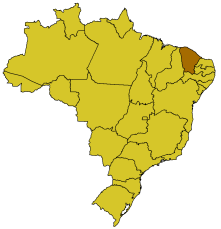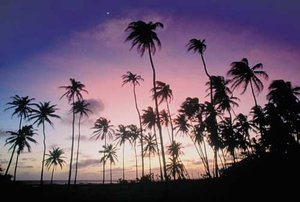|
|
| Statistics | ||
|---|---|---|
| Capital: | Fortaleza | |
| Area: | 148,016km² | |
| Population: | 6,500,000 | |
| Pop. density: | 43.9 inh./km² | |
| Timezone: | GMT -3 | |
| ISO 3166-2: | BR-CE | |
| Temperatures: | 22°C to 36°C | |
| Governor: | Lúcio Alcântara | |
| Map | ||
 | ||
Ceará is one of the states of Brazil, located in the northeastern part of the country, on the Atlantic coast.
| Contents |
Geography
Ceará has a varied environment, with mangroves, caatinga, jungle, scrubland and temperate forest. However, it is hot almost all year round. This environment and temperature attracts many tourists, especially ecotourists. The temperature in the state varies from 22°C to 36°C with the lowest temperatures not being typical in the capital Fortaleza but in the innumerous mountains in the state.
CearaMapCoastalArea.png
Coast of the Ceará State
The endless stretch of beaches in the state is a major tourist attraction. Ceará has several famous beaches such as Canoa Quebrada, Jericoacoara, Morro Branco, Taíba and Flexeiras. The beaches are divided into two groups (in relation to the capital Fortaleza): Sunset Coast (Costa Solpoente) and Sunrise Coast (Costa Solnascente).
History
Ceará was first colonised by the Portuguese in the middle of the 1600s, when what is today Brazil was hotly contested by the Dutch and the Portuguese.
The area was invaded twice by the Dutch, in 1644 and in 1654. Both times the settlers repelled them. Before being defeated, however, the Dutch founded what is today Fortaleza. In 1661, the Netherlands formally ceded their Brazilian territories to the Portuguese crown, ending conflict in the region.
The fight for Brazilian independence in 1822 was fierce in Ceará, with the area being a rebel stronghold that incurred vicious retribution from loyalists.
The reign of Dom Pedro II (see Empire of Brazil) saw great advances in infrastructure in Ceará, with the number of telephones increasing by a large amount, and with gas lighting becoming almost ubiquitous.
In 1960, a the Orós Dam, comparable in size to the Aswan Dam has supplied Ceará with much of its water, and in 1995 construction began on the enormous Castanhão Dam, which, when completed, will be able to hold 6.5 billion m³ of water.
Flag
The flag of Ceará is identical to that of the federal Brazilian flag, however, the blue hemisphere in the Brazilian flag is replaced by the Ceará state coat of arms.
Economy
Traditionally an agriculture based state, Ceará began a industrialisation programme in the early 20th century, and the industrial sector continues to expand annually. In 1994, industry accounted for 35% of the state's GDP. Tourism also plays a large part in Ceará's economy, with the state's many waterfalls, beaches and rainforests. On average, Fortaleza alone receives half a million tourists annually.
Tourism
The state has several tourist attractions but is famous for its eco-tourism capabilities with hundreds of nearly deserted beaches and sand dunes.
Fortaleza's international airport (named Pinto Martins airport) is well served by international flights from North and Central America as well as Europe.
Main Tourist Attractions
- Canoa Quebrada Beach (in Aracati)
- Jericoacoara Beach
Cities
see Brazilian cities
External links
- Official Government Site (http://www.ceara.gov.br)
- Tourism guide Ceará (http://www.ceara.com.br)
- Fortaleza Tourism guide and maps (http://www.ceara.com.br/fortaleza)
- Ceará Photos (http://www.ceara.com.br/Fotos_Fortaleza/fortaleza_fotos.htm)
| States of Brazil | 
|
|---|---|
| Acre | Alagoas | Amapá | Amazonas | Bahia | Ceará | Espírito Santo | Goiás | Maranhão | Mato Grosso | Mato Grosso do Sul | Minas Gerais | Pará | Paraíba | Paraná | Pernambuco | Piauí | Rio de Janeiro | Rio Grande do Norte | Rio Grande do Sul | Rondônia | Roraima | Santa Catarina | São Paulo | Sergipe | Tocantins | |
| Federal District: Brazilian Federal District | |
et:Ceará es:Ceará eo:Cearao fr:Ceará gl:Ceará ka:სეარა nl:Ceará no:Ceará pl:Ceara pt:Ceará sv:Ceará zh:塞阿腊


